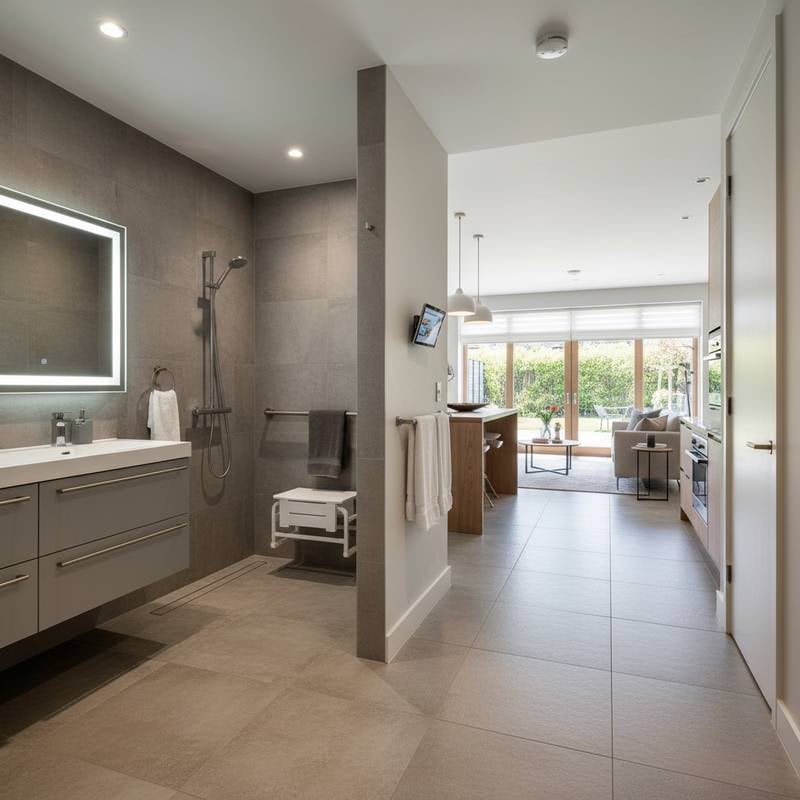Basement Conversion: ADU or Living Space for 2025?
Category: Remodeling Guides
Introduction to Your Basement Decision
Deciding how to transform your basement in 2025 involves weighing two distinct options: an Accessory Dwelling Unit (ADU) or a living space integrated with your main home. This guide provides practical design advice, current permitting insights, cost breakdowns, and a detailed roadmap to help you choose the path that aligns with your goals. Whether you aim for rental income or enhanced family functionality, understanding the nuances of each option is crucial.
Visualizing the Two Paths
A basement conversion hinges on three key factors: zoning regulations, budget constraints, and intended use. An ADU operates as a self-contained unit with its own kitchen, bathroom, and entrance, ideal for generating rental income or housing extended family. A basement living space, by contrast, extends your primary residence for uses like a home theater or gym, sharing utilities and access. Your decision will rest on financial objectives, household needs, and local building codes.
Defining the Options
ADU Basement: A Separate Residence
An ADU is a legally distinct unit within your property, complete with private amenities and often a separate address. This setup appeals to renters seeking independence or homeowners needing space for multigenerational living. The added privacy and utility separation boost its marketability, though it demands stricter compliance with zoning and safety codes.
Basement Living Space: Expanding Your Home
A living space remains part of your main residence, sharing utilities and access points. It serves as a versatile area for family activities, guest accommodations, or personal hobbies. This option typically involves simpler permitting and lower costs, maintaining the home under one cohesive management structure.
Trends Influencing 2025 Conversions
Zoning laws are becoming more ADU-friendly in many regions, with reduced lot size restrictions and expanded square footage allowances. Stricter energy codes introduced in 2024 mandate enhanced insulation and ventilation, impacting permit requirements. Smart home technologies, such as integrated lighting and security systems, simplify remote management for ADU owners. Market trends also indicate growing demand for private basement units, with finished spaces offering strong resale value.
Cost Breakdown and Permitting Steps
Cost Estimates for a 1,200 Square Foot Basement
- ADU Basement: $60,000 to $90,000 total investment.
- Basement Living Space: $40,000 to $65,000 total investment.
Key expenses include design fees, waterproofing, interior finishes, and mechanical installations. Costs vary by region, with areas like the Pacific Northwest often at the higher end due to labor rates.
Essential Permitting Checklist
- Verify zoning laws to ensure ADUs are permitted on your property.
- Address fire safety by installing egress windows meeting size standards and adding smoke detectors.
- Confirm mechanical requirements, noting that ADUs often need separate utility meters while living spaces may share systems.
- Comply with 2024 energy codes for insulation and ventilation standards.
Begin the permitting process early to avoid delays or redesigns.
Design Strategies for Success
Enhancing Natural Light
Maximize daylight by installing egress windows with high R-value glazing and consider light wells where zoning permits. Position windows to brighten key areas like living rooms or kitchens. These choices improve ambiance and energy efficiency.
Optimizing Space Layout
For an ADU, design a compact kitchen within an 8 to 10-foot footprint, a full bathroom, and a private entrance. For a living space, create flexible zones like a media room or gym, paired with storage near entry points. Ensure ceiling heights meet minimum code requirements, typically 7 feet for ADUs.
Controlling Sound and Moisture
Reduce noise transfer by installing resilient channels and acoustic insulation between floors. Apply a dual waterproofing system with drainage boards and liquid membranes before framing. Equip the space with a sump pump featuring battery backup and Wi-Fi alerts to guard against leaks.
Financing Options and Return on Investment
Home equity lines of credit (HELOCs) and renovation loans are common funding sources, with some states offering ADU-specific programs at lower rates. Basement remodels can recover up to 70 percent of costs at resale, while ADUs may yield higher returns through consistent rental income in supportive markets.
Actionable Roadmap to Completion
- Evaluate feasibility by checking ceiling height and testing for water intrusion.
- Define your primary goal, whether income from an ADU or family utility from a living space.
- Engage a licensed architect or designer knowledgeable about local ordinances.
- Submit comprehensive permit applications, including site plans and energy calculations.
- Select durable materials like low-VOC paints and LED lighting for long-term value.
- Phase construction, starting with waterproofing, followed by mechanical systems, then finishes.
- For ADUs, secure rental licenses, install separate meters, and draft compliant leases.
Avoiding Common Mistakes
Underestimating waterproofing budgets can lead to mold and expensive fixes; conduct moisture tests upfront. Neglecting egress window standards risks safety violations and permit rejections. Overloading electrical systems causes hazards, so install a dedicated sub-panel for ADUs. Skimping on insulation or soundproofing may fail inspections or annoy occupants, so prioritize quality materials.
Real-World Examples
Seattle ADU Success
A 1,050 square foot ADU within a 2,200 square foot home cost $78,000, featuring energy-efficient appliances. It rents for $2,200 monthly, offsetting most of the homeowner's mortgage.
Austin Living Space Transformation
An 8-foot ceiling basement became a home theater and guest suite for $55,000. The home's appraisal increased by $45,000, adding significant family utility.
Moving Forward with Confidence
Clarify your objectives, review local zoning, and consult professionals for a detailed feasibility study. Focus on robust waterproofing, code adherence, and smart system integration to ensure lasting value. Whether prioritizing income or family needs, a well-planned basement conversion enhances your property's worth and functionality.










